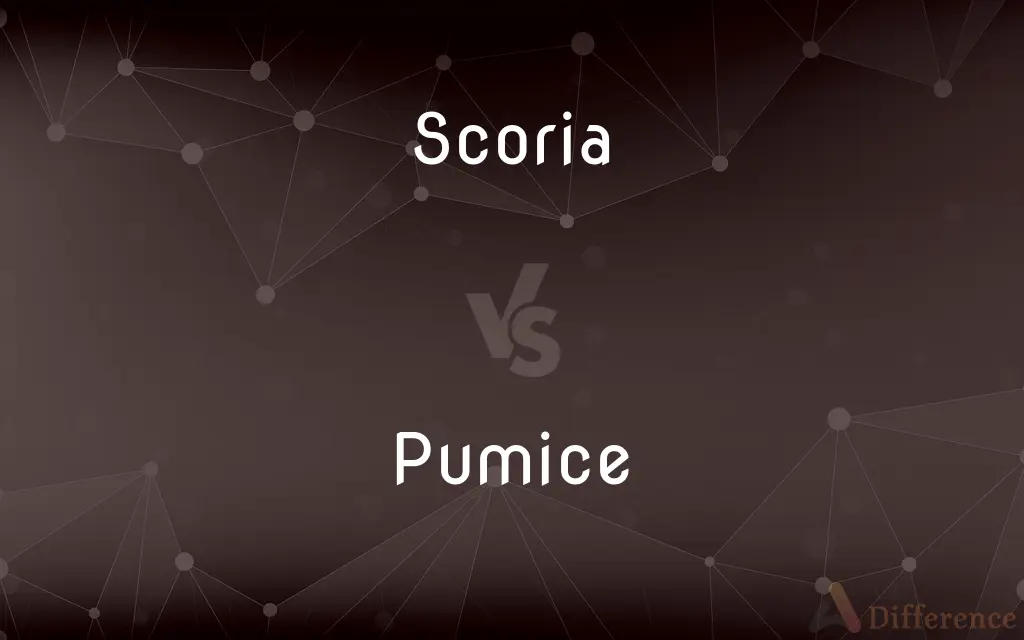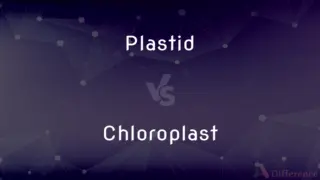Scoria vs. Pumice — What's the Difference?
By Fiza Rafique & Urooj Arif — Updated on May 6, 2024
Scoria is a dark, vesicular volcanic rock often heavier and with larger vesicles compared to pumice, which is lighter, highly porous, and can float on water.

Difference Between Scoria and Pumice
Table of Contents
ADVERTISEMENT
Key Differences
Scoria is typically dark-colored, ranging from black to dark red, and is denser than pumice, which is usually light-colored, ranging from white to light grey. Scoria forms from magma that is rich in iron and magnesium, whereas pumice forms from highly explosive volcanic eruptions that release volcanic glass.
Both scoria and pumice are vesicular, meaning they contain cavities formed by gas bubbles. However, scoria's vesicles are larger and less numerous than those in pumice, which has a highly vesicular structure with closely packed, often interconnected bubbles.
Due to its lower density and high porosity, pumice is capable of floating on water, at least until it becomes waterlogged. Scoria, being heavier, typically sinks.
The formation of scoria generally occurs during relatively peaceful eruptions as lava cools rapidly and gases escape, forming the vesicles. Pumice, on the other hand, is formed during highly explosive eruptions where the rapid cooling of lava traps gases within a highly porous rock.
In practical uses, scoria is often used in landscaping and drainage applications due to its heavier weight and durability, while pumice is commonly used as an abrasive in polishes and exfoliants due to its light weight and abrasive texture.
ADVERTISEMENT
Comparison Chart
Color
Typically dark (black to red)
Typically light (white to light grey)
Density
Heavier, sinks in water
Lighter, can float on water
Vesicle Size
Larger, fewer
Smaller, more numerous and interconnected
Formation
Peaceful volcanic eruptions
Explosive volcanic eruptions
Common Uses
Landscaping, drainage
Abrasive materials, exfoliants
Compare with Definitions
Scoria
Typically found near volcanoes.
Large amounts of scoria can be found around the base of active volcanoes.
Pumice
Used as an abrasive material.
Ground pumice is used in toothpaste to polish teeth.
Scoria
Formed from magma with high iron and magnesium.
The geology tour emphasized scoria’s origin from iron-rich magma.
Pumice
Forms during explosive volcanic eruptions.
The pumice layer in the sediment indicates a past explosive volcanic event.
Scoria
A dark volcanic rock with vesicles.
Scoria is commonly used in garden beds for its decorative appearance and drainage properties.
Pumice
A light, porous volcanic glass.
Pumice stones are popular in spas for removing dry skin.
Scoria
Heavier and denser volcanic rock.
Unlike pumice, scoria does not float when placed in water.
Pumice
Can float on water due to high porosity.
Pumice rocks can often be seen floating on water near volcanic islands.
Scoria
Used in heavy-duty construction.
Scoria was chosen for the construction project due to its durability.
Pumice
Highly vesicular structure.
The numerous, tightly packed vesicles make pumice uniquely light.
Scoria
Scoria is a highly vesicular, dark-colored volcanic rock that may or may not contain crystals (phenocrysts). It is typically dark in color (generally dark brown, black or purplish red), and basaltic or andesitic in composition.
Pumice
Pumice ( ), called pumicite in its powdered or dust form, is a volcanic rock that consists of highly vesicular rough textured volcanic glass, which may or may not contain crystals. It is typically light colored.
Scoria
(Geology) Porous cinderlike fragments of dark lava. Also called cinders, slag.
Pumice
A light, porous, glassy lava, used in solid form as an abrasive and in powdered form as a polish and an abrasive.
Scoria
(Metallurgy) The refuse of a smelted metal or ore; slag. Also called cinder.
Pumice
To clean, polish, or smooth with pumice.
Scoria
The slag or dross that remains after the smelting of metal from an ore.
Pumice
A light, porous type of pyroclastic igneous rock, formed during explosive volcanic eruptions when liquid lava is ejected into water or air as a froth containing masses of gas bubbles, which are frozen into the rock as the lava solidifies.
Scoria
(geology) Rough masses of rock formed by solidified lava, and which can be found around a volcano's crater.
Pumice
(transitive) To abrade or roughen with pumice.
Scoria
The recrement of metals in fusion, or the slag rejected after the reduction of metallic ores; dross.
Pumice
A very light porous volcanic scoria, usually of a gray color, the pores of which are capillary and parallel, giving it a fibrous structure. It is supposed to be produced by the disengagement of watery vapor without liquid or plastic lava. It is much used, esp. in the form of powder, for smoothing and polishing. Called also pumice stone.
Scoria
Cellular slaggy lava; volcanic cinders.
Pumice
A light glass formed on the surface of some lavas; used as an abrasive
Scoria
The scum formed by oxidation at the surface of molten metals
Common Curiosities
What is scoria typically used for?
Scoria is typically used for landscaping, drainage solutions, and as aggregate in lightweight concrete.
How does pumice float on water?
Pumice floats on water due to its extremely porous structure, which traps enough air to keep it buoyant.
What causes the dark color of scoria?
The dark color of scoria is due to its high iron and magnesium content, which oxidize upon exposure to air.
Are scoria and pumice found worldwide?
Scoria and pumice can be found in volcanic regions around the world, although their presence and abundance may vary.
Why is pumice used in beauty products?
Pumice is used in beauty products for its abrasive properties, effective in removing dead skin and polishing surfaces.
Can the vesicles in scoria and pumice tell us about their formation?
Yes, the size and distribution of vesicles can indicate the speed of cooling and the volatility of the eruption, with more explosive eruptions producing finer, more interconnected vesicles as seen in pumice.
What environmental impacts are associated with mining scoria and pumice?
Mining scoria and pumice can disrupt local ecosystems, although impacts vary depending on the scale and method of extraction.
Can scoria be used in water filtration?
Yes, scoria's porous nature and durability make it suitable for use in water filtration systems.
What are the safety considerations when using pumice?
When using pumice, particularly as an abrasive, it is important to handle it gently to avoid excessive abrasion and skin damage.
How are scoria and pumice extracted?
Both scoria and pumice are mined from volcanic deposits, often using quarrying methods.
Share Your Discovery

Previous Comparison
Workshop vs. Tutorial
Next Comparison
Plastid vs. ChloroplastAuthor Spotlight
Written by
Fiza RafiqueFiza Rafique is a skilled content writer at AskDifference.com, where she meticulously refines and enhances written pieces. Drawing from her vast editorial expertise, Fiza ensures clarity, accuracy, and precision in every article. Passionate about language, she continually seeks to elevate the quality of content for readers worldwide.
Co-written by
Urooj ArifUrooj is a skilled content writer at Ask Difference, known for her exceptional ability to simplify complex topics into engaging and informative content. With a passion for research and a flair for clear, concise writing, she consistently delivers articles that resonate with our diverse audience.
















































